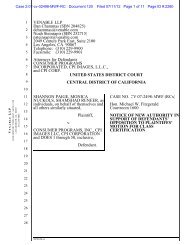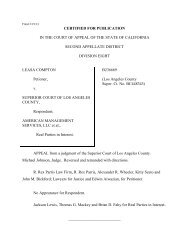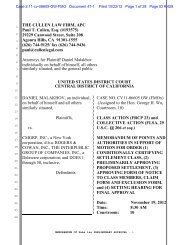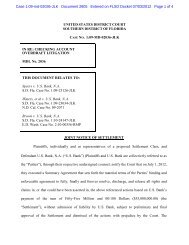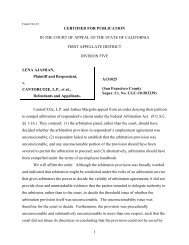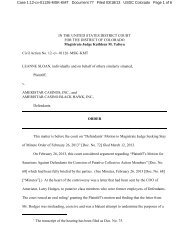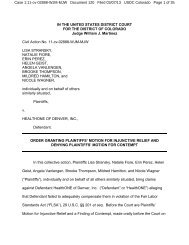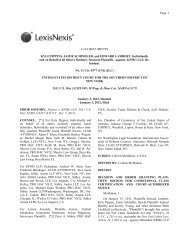order denying motion to decertify - Impact Litigation Journal
order denying motion to decertify - Impact Litigation Journal
order denying motion to decertify - Impact Litigation Journal
Create successful ePaper yourself
Turn your PDF publications into a flip-book with our unique Google optimized e-Paper software.
Case 3:05-cv-01018-GPC-WVG Document 394 Filed 02/14/13 Page 6 of 9<br />
1<br />
2<br />
3<br />
4<br />
5<br />
6<br />
7<br />
8<br />
9<br />
10<br />
11<br />
12<br />
13<br />
14<br />
15<br />
16<br />
17<br />
18<br />
19<br />
20<br />
21<br />
22<br />
23<br />
24<br />
25<br />
26<br />
27<br />
28<br />
proximate cause as well.” Hemi Group, 130 S. Ct. at 989 (internal quotations omitted). “Proximate<br />
cause for RICO purposes . . . should be evaluated in light of its common-law foundations; proximate<br />
cause thus requires some direct relation between the injury asserted and the injurious conduct alleged.”<br />
Id. (internal quotation omitted). “A link that is <strong>to</strong>o remote, purely contingent, or indirect is<br />
insufficient.” Id. (internal quotations omitted).<br />
“In some cases, reliance may be a ‘milepost on the road <strong>to</strong> causation.’” Paulos v. Caesars<br />
World, Inc., 379 F.3d 654, 664-65 (9th Cir. 2004). Indeed, in holding that first-party reliance is not<br />
an element of a civil RICO claim predicated on mail fraud, the Supreme Court noted that “none of this<br />
is <strong>to</strong> say that a RICO plaintiff who alleges injury ‘by reason of’ a pattern of mail fraud can prevail<br />
without showing that someone relied on the defendant’s misrepresentations.” Bridge v. Phoenix Bond<br />
& Indemnity Co., 553 U.S. 639, 649 (2008) (emphasis in original).<br />
Here, Judge Sammartino observed that “Plaintiffs have established causation by showing<br />
reliance on the alleged misrepresentations,” and that Plaintiff s could demonstrate reliance on a classwide<br />
basis given (1) the prominent nature of the alleged misrepresentations, (2) the fact that seniors<br />
were required <strong>to</strong> sign an acknowledgment that they read and unders<strong>to</strong>od the materials containing the<br />
alleged misrepresentations, and (3) the availability of class-wide proof connecting the alleged<br />
misrepresentations <strong>to</strong> diminished returns. This Court agrees that this evidence provides a method for<br />
Plaintiffs <strong>to</strong> establish proximate causation on a classwide basis.<br />
As Judge Sammartino noted, the district courts in Garner, 184 F.R.D. 598, and Peterson, 174<br />
F.R.D. 78 (N.D.Ill.1997), certified classes because reliance could be inferred through a common sense<br />
link between a defendant’s alleged misrepresentations or omissions and the class members’ actions.<br />
Moreover, as noted by Plaintiffs, the Central District of California concluded in both Negrete I and<br />
Negrete II that evidence of standardized written presentations coupled with evidence that the annuities<br />
offered in that case were worth less than similar products sufficed <strong>to</strong> demonstrate causation on a class<br />
wide basis. Negrete II, 2012 WL 6737390, at *20 (C.D. Cal. Dec. 27, 2012); Negrete I, 238 F.R.D.<br />
at 492.<br />
As National Western correctly notes, however, there have been instances where courts have<br />
refused <strong>to</strong> apply a common sense approach.<br />
6 3:05-cv-1018-GPC-WVG



